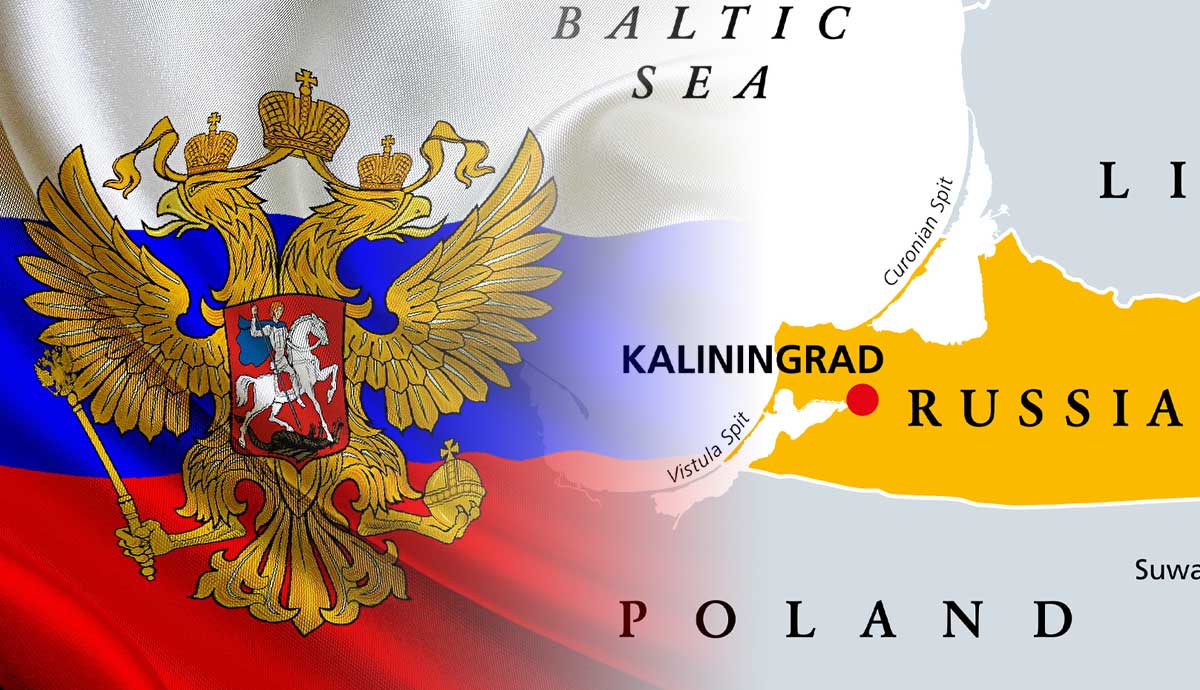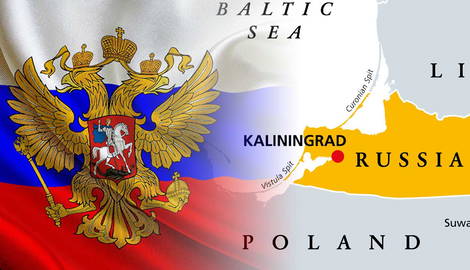
On the Baltic coast, wedged between Lithuania and Poland, is a piece of land 230 miles (270 kilometers as the crow flies) from the border of the Russian mainland. This is Kaliningrad, and to reach it from the rest of Russia, one has to travel through Lithuania and either Belarus or Latvia.
Given that this exclave exists, the question arises: why does it belong to Russia?
Where and What Is Kaliningrad?

Representing the westernmost point of Russia, Kaliningrad Oblast is a piece of land sandwiched between Lithuania and Poland on the Baltic coast. Roughly halfway between Minsk and Berlin, the capital of Kaliningrad Oblast is the city of Kaliningrad, with an estimated population of around 450,000 people.
The entire oblast has a population of over one million people and covers an area of 5,840 square miles (slightly smaller than Delaware).

The region’s geography is of primary importance. It is Russia’s only ice-free port on the Baltic Sea, and thus, it is crucial for the Baltic fleet. Given the current political climate, it is also highly militarized.
The Curonian Spit, a 61-mile-long sand-dune spit that separates the Baltic Sea from the Curonian Lagoon, is of interest to tourists and naturalists. This UNESCO World Heritage Site, shared by Lithuania and Russia, attracts vacationers and those studying wildlife.
Today, four of five Kaliningrad residents identify as ethnic Russians.
Crusaders

The history of ownership of Kaliningrad can be traced back many centuries. A good starting point, however, is the Crusades and the Teutonic Order. The wars against Muslims in the Holy Land did not achieve the desired results for Christians, and the Teutonic Order began looking for victory elsewhere.
Fortunately, there were plenty of opportunities to be had, and they found themselves invited to help defend Hungary from Cuman tribes invading from the east. After trying to build their own independent state in Transylvania, King Andrew II of Hungary expelled the Teutonic Knights from Hungarian lands by force in 1225.
Looking for conquest, the Teutonic Knights found a worthy target to the north, where paganism was still the dominant religion. Being crusaders, the Teutonic Knights took it upon themselves to convert these lands to Catholicism and waged war against the Old Prussian tribes in the area.

Under Prince Konrad I, the Poles had been waging war against these pagans. He invited the Teutonic Order to join him on his crusade. With the blessing of the Pope and the Holy Roman Emperor, the Teutonic Order was guaranteed ownership over any land they conquered.
Thus, through conquest, the Teutonic Order created the State of the Teutonic Order, stretching along the Baltic coastline and incorporating lands in what is today northern Poland, Kaliningrad, and the Baltic States.
The pagans who lived in these regions, such as the Old Prussians, were converted to Christianity and assimilated. Those who refused were exterminated. Thus began a demographic shift as the natives were suppressed, and Germanic people from the west began immigrating to the new territories under Teutonic control.
In 1255, the city of Königsberg was founded, which would much later become the city of Kaliningrad.
Vassal State

The Teutonic Knights were crusaders and desired to convert those around them. With few actual pagans left, they targeted the Lithuanians, claiming that the Lithuanians weren’t proper Christians. This attitude obviously caused conflict between the Teutonic Knights and the Polish Lithuanian Commonwealth. After a series of wars, the Teutonic state was defeated in 1521 and forced to become a vassal state of Poland. What was once a powerful state was now Ducal Prussia, a territory subservient to the Polish crown.
German influence in the area, and subsequently Protestantism, was considerable. The Hohenzollern family from Berlin showed significant interest in these developments and treated with the Polish king.
The last leader of the Teutonic Order was Hochmeister Albrecht von Brandenburg-Ansbach, related to the Hohenzollerns who held lands mainly around Berlin. Albrecht von Brandenburg-Ansbach died without an heir, and the Hohenzollern family asked if they could put one of their own on the throne. The Polish king agreed as long as they remained vassals of Poland. The deal was struck, and the patchwork of lands belonging to the Hohenzollern was united with the Prussian lands to form Brandenburg-Prussia in 1618.

In 1655, Poland suffered a major catastrophe when it found itself at war with both Russia and Sweden. Elector Friedrich Wilhelm of Brandenburg-Prussia was in an odd situation as a result. Half his territory, as a vassal to Poland, was now at war with Sweden, and the other half was not. When Sweden captured significant parts of Prussia in December of that year, Friedrich Wilhelm used the situation to his advantage.
He surrendered to Sweden and declared the Duchy of Prussia a vassal of Sweden. Obliged by this vassalage, he declared war on Poland as well. The war, however, did not progress well for Sweden. The tide of the war turned, and Sweden was put on the defensive.
With major military problems, Sweden now relied even more on the Duchy of Prussia for support. Friedrich Wilhelm used this reliance to demand recognition of Prussian sovereignty, which was granted.
Other European powers united against Sweden and brokered a deal in which Friedrich Wilhelm would switch sides and ally with Poland in return for very favorable terms that guaranteed Prussian sovereignty. Friedrich Wilhelm accepted.
Sweden, however, pulled back from the brink of disaster and actually won the war. The Swedish victory was mostly against Denmark, and they did not press claims on Prussia. Denmark handed over the territory of Skåne to Sweden, which is still a part of Sweden to this day.
Prussia

In the late 18th century, the winds of fortune blew heavily against Poland. Weakened by civil war and Russian intervention, Poland could do little to defend itself from political developments. Austria, Russia, and Prussia became so powerful that they simply carved up Poland between them. For Prussia, the lands around Berlin and the Prussian lands in the east finally became contiguous.
Over the next century, Prussia was defeated by Napoleon, but after Napoleon’s defeat, Prussia once again became a powerful militaristic state. Under the guidance of Otto von Bismarck, Prussia was united with the rest of Germany in 1871, and the Second Reich was born. At its far northeastern territory, in East Prussia, lay the city of Königsberg, still very much a German city inhabited by ethnic Germans. They were, however, seen as backward by other Germans. Pan-Germanist politician Ernst Hasse stated they “had almost no folk identity.”
The 20th Century

In the First World War, Königsberg was threatened by the Russians, who saw victory and pushed towards the outskirts of the city. Subsequent German victory at Tannenberg, however, completely reversed Russian fortunes. After the tsar was deposed and the Bolsheviks came to power, Russia pulled out of the war at the expense of vast tracts of land.
At the end of the Second World War, with the Red Army’s sweeping advances, two million people fled Königsberg, and the Soviets captured the areas surrounding the city, although Königsberg itself wasn’t captured by the time Germany surrendered on May 8.
The Potsdam Agreement, signed on August 1, 1945, turned Königsberg and surrounding lands over to Soviet control. In 1946, the city was renamed Kaliningrad, and efforts were made to repopulate it with Soviet citizens, mainly from Russia. Stalin forcibly expelled the Germans who were living there.

Massive projects were undertaken to create industry in the city and provide infrastructure for this new Soviet possession. Kaliningrad’s Russification was almost absolute. As to why it was not added to the Lithuanian SSR (the Baltic States were part of the Soviet Union), it has been suggested that Stalin wanted Kaliningrad to act as a buffer between the Baltic States and the West.
In December 1991, the Soviet Union collapsed, and many of its constituent republics became independent states. This was also true for Belarus and the Baltic States. Since Kaliningrad had been part of the Russian Soviet Federated Socialist Republic, it remained part of Russia as an exclave, separated from the Russian mainland. Traveling from one to the other requires transit across two countries.
Given Germany’s history and the fact that Kaliningrad is populated by a vast majority of Russians, Germany does not intend to promote any claims on the territory.
According to an article published in Der Spiegel in 2010, in 1990, Russia offered Kaliningrad back to West Germany, but the West Germans did not accept the offer.
The 21st Century

Although Belarus has remained a firm ally of Russia, Poland and the Baltic States moved very quickly into the Western sphere of influence after the collapse of the Soviet Union. As such, Kaliningrad has become, from a Russian perspective, surrounded by hostile territory.
In 1999, Poland joined NATO, and in 2004, Lithuania, Latvia, and Estonia joined the alliance, putting considerable strain on relations between Russia and the West. From then on, relations slowly deteriorated, and Kaliningrad became increasingly fortified and militarized.
Today, Kaliningrad is an important outpost for Russia, and it acts as a potential launching pad for missiles that were installed as a response to the installation of missiles in NATO countries.
With former US President Donald Trump’s withdrawal from the 1987 Intermediate-Range Nuclear Forces (INF) Treaty in 2019, Kaliningrad’s status as a military outpost has become even more critical. The treaty imposed limits on the installation of missiles in Europe. Once considered to be so important that it likely averted a third world war, this treaty now lies in the dustbin of history, and there is no political effort to revive it.
Kaliningrad is the headquarters of Russia’s Baltic Fleet. For centuries, Königsberg was the most fortified garrison city in Prussia because of its commanding position on the Baltic Coast. This value is still as true today as it has ever been.

Recent events in Ukraine have soured the relationship between Russia and the West even further. EU sanctions imposed by Lithuania affected Kaliningrad and efforts were increased to supply Kaliningrad via sea routes. The sanctions, however, were lifted as the EU clarified that Lithuania could not enforce blockage of transport by rail and that the EU sanctions only applied to goods transported by road.
For Kaliningrad, this is of vital importance as it lies closer to many European trading partners than it does to Russian destinations.
From a cartographic perspective, Kaliningrad exists as an interesting anomaly. The reality of its existence, however, is serious. It plays a significant part in strategic dynamics in Eastern Europe, and considerable attention will likely fall on Kaliningrad in the future if relations between Russia and the West deteriorate even further. Like Germany and Prussia before it, the Kaliningrad region is vital to Moscow from a geopolitical perspective rather than an economic one. Its strategic location gives Russia benefits in terms of access to Europe—benefits that it considers to be of vital strategic importance.
For the West, this represents a military danger. How this dynamic will play out can only be the subject of speculation.










